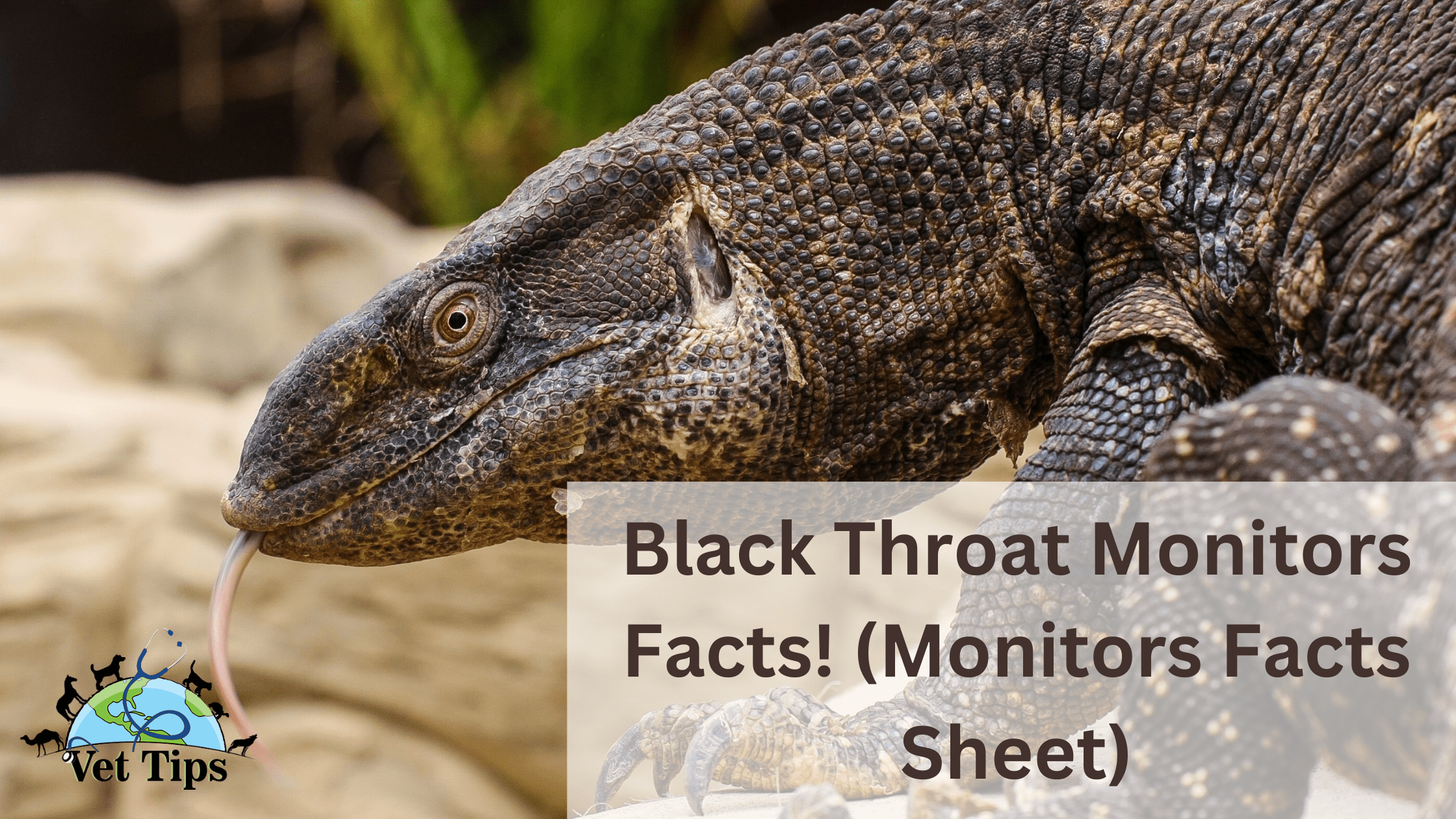As a pet parent, we all love Monitors. But with love came many responsibilities to keep these lizards as pets. So, in this post we discuss all Black Throat Monitors Facts! (Monitors Facts Sheet).
Let’s begin.
Black Throat Monitor Facts
- Black Throat Monitors can break their thyroid bone to expand their mouths while eating larger prey.
- Black Throat Monitors have forked tongues like snakes. The chemical receptors on their tongue help in detecting prey’s location with better accuracy.
- Black throat monitors are incredibly territorial. This feature is more prominent in males. Males even fight each other on the territory or female issues. They bite and injured themselves severely while fighting.
- Black throat monitors prefer to hunt in the open instead of ambushing. They run very fast due to advanced and powerful limb muscles. They swallow their food in large chunks or eat the whole prey.
- Rodent dens and various termite mounds are places where they lay their eggs. Even they have long claws and powerful jaws, they prefer to lay eggs there due to their instincts
- Black-throated Monitors use their tails for defense, swimming in the water, or even grasp their prey. They have a very robust and reliable tail, which is about two-thirds of their body size
- Their tails are twice in size as compared to their body.
- They have mottled gray-brown or brownish-black scales with yellow or white markings.
Cool Facts
- They can even be walked on leashes, like other pets.
- They like to rub their prey in the soil.
- Black-Throated Monitors can be as intelligent and friendly as dogs.
- Monitors shed their teeth and grow new ones all through their lives.
- They can recognize their keepers.
- They are the heaviest bodied lizard in Africa
- The neck and head are the same length and are distinct from each other.
Fast Facts
General Description
Black-Throated Monitor Lizards are giants by nature. They have short but strong muscular legs, giant claws, sharp teeth, and long fat tails. Like all other reptiles, they have rough and thick skin for protection against large predators and prey that fight back. These Monitors are generally calm tempered reptiles, but they hiss when they sense a threat and inflate their bodies to make themselves seem more bulky and significant. They also whack predators with their robust and powerful tails. Sometimes they will even try to bite if the predator gets close. They have long, forked tongues (like snakes) to sense odors. They prefer to eat live prey in the wild, but they mostly eat dead animals such as mice, rats, other rodents, and even smaller chickens in captivity. Since these Black Throat monitors are not social creatures, they might turn aggressive if not trained or handled regularly in captivity. These giant Monitors love to spend their days climbing trees or digging to stay calm or take a nap.
Average Size:
160-200 cm (63-80 in.); maximum 272 cm (9.1 ft)
Average Weight:
Up to 11.5 kg (26 lbs.)
Incubation Period:
20 days +/- 1 day
Clutch Size: 22-50 eggs
Age at Sexual Maturity
3.5-5 years
Average Life Span:
13-20 years
Range:
Zimbabwe, Namibia, South Africa to northern Ethiopia
Population:
Global: No data
Other Facts:
Sexual Dimorphism:
Male Monitors will grow much faster than female Monitors.
Specifications of species:
The Black-throated Monitor is a member of the Varanidae family of lizards. Due to recent changes and conflicting use of common names, there is some confusion about this species’ actual taxonomic classification. It was thought that Black Throat Monitors are sub-species of white-throat monitors. Now, black-necked monitors and white-necked monitors are considered different species
Housing
The black throat monitor is territorial. This Monitor lives in various dry habitats, including prairies, steppes, and savannas, but is missing from rainforests, deserts, and dense bushes.
Food
Restricted eaters plus obligate carnivores. They will eat anything they can catch. They eat prey in captivity, such as rats, lizards, mice, mollusks (freshwater), snakes, small birds, large roaches, fish, eggs, and crustaceans.
Activity and behavior
Black-throated Monitor social behavior
The Hunting area for a male is approximately 7.5 square miles from home, while for females, it is 2.5 square miles. Their range reduces up to many folds in the dry season.
Reproductive behavior of Black Throat Monitors
Their breeding season starts in mid-August and ends at the start of October. Females prefer to do mating on trees. They climb a tree and wait for the counter partner to come.
When the males get the female, they will stay together for 3-4 days, after which the female will lay 1-2 egg clusters/clutches and put them in burrows.
Black Monitors Offspring
The incubation period of the Black Monitors egg is 35-37 days. They deposit their eggs at different sites. Some Monitor females seem to prefer digging their nests into almost the rock hard bottoms of the ant or termite mounds.
Nature creates an extraordinary phenomenon to save their eggs for the sustainability of this species. Naturally, the termites rebuild their mounds around the eggs in the wild to retain the humidity essential for their existence, thus protecting the Black Monitor eggs encased inside their mounds and also provide them with the optimal moisture they need.
These Monitors are adapted to bury their eggs in moist soil that retains moisture. When variations occur in regular moisture or environment, these eggs can take a year to hatch!
Monitors Conservation Status
- Monitors are at considerable risk because of their requirements for large areas of their optimum habitat.
- They are considered somewhat endangered because of excessive hunting and killing in the past for food.
Their leathery coat is also costly, so they also become the victim of the illegal leather trade. - Local people also kill them due to fear or for some spiritual reasons
- Black Monitors body organs and their skin is also used in some local and traditional medicine.
Fascinating Fact About Black Monitor Family
All species of Family Varanus are called Cape Monitors. Black Throat Monitor is also included in it. This Family consists of 32 species and almost 60 subspecies; this also includes the largest lizards on Earth or in existence, the Komodo Dragon, which can reach up to 10.2 feet in length, and the smallest is the seven-inch short-tailed Monitor.
Tell us in the comments how you like our article, “Black Throat Monitors Facts! (Monitors Facts Sheet)”
For Similar Posts Click Here
For Source File Click Here






One thought on “Black Throat Monitors Facts! (Monitors Facts Sheet)”